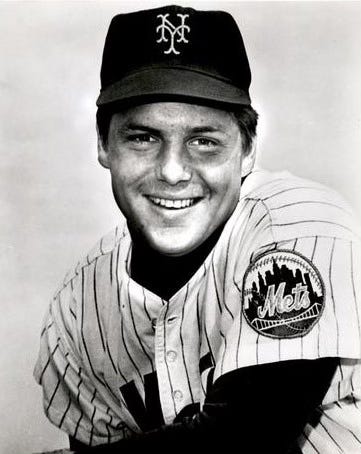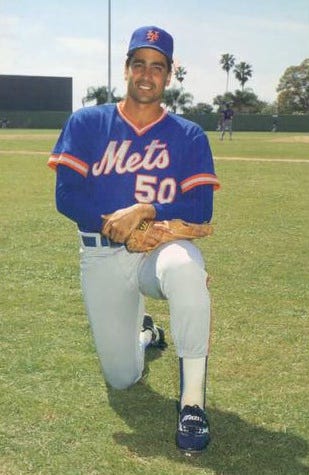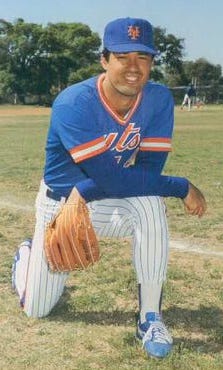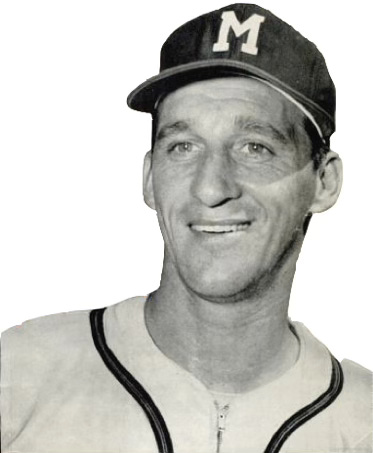The Mets' All-Time Arms Race
The top four might be simple. Numero five-o? Not so fast, Buster . . .
Pregame Pepper
. . . The first five Mets pitchers to become National League All-Stars: Tom Seaver, Jerry Koosman, Tug McGraw, Jon Matlack, and Pat Zachry.
. . . The top five Mets pitchers for single-season walks/hits per inning pitched (WHIP; rounded up): Jacob deGrom (0.91, 2018), Matt Harvey (0.93, 2913), Tom Seaver (0.95, 1971), Pedro Martinez (0.95, 2005), and deGrom (0.96, 2020). (Seaver is ahead of Martinez, technically, with an actual 0.946 vs. 0.949).
. . . The top five Mets pitchers for single-season fielding-independent pitching (FIP; definition below): Dwight Gooden (1.69, 1984), Tom Seaver (1.93, 1971), Jacob deGrom (1.98, 2018), Matt Harvey (2.01, 2013), and Gooden (2.13, 1985).

The Top Five: The Mets’ All-Time Arms Race
Who are they, for a franchise so rich in pitching for so long?
By Mark Kolier

For a team known historically as having good starting pitching, the 2025 Mets thrive without a number one starter so far. The Mets have generally been very good at finding and nurturing starting pitchers. There was a time, under then-general manager Frank Cashen and assistant GM Joe McIlvaine, that if a team received a call from the Mets about one of their starting pitchers, it was time to give that pitcher a raise.
The starting pitcher role has been diminished in today’s MLB. All teams and particularly the longest-tenured franchises, have many all-time great starting pitching alumni. The Mets, born in 1962, have a rich history for a ‘younger’ team.
Who are the five greatest Mets starting pitchers in team history?
The top three are easy-peasy: Hall of Famer Tom Seaver, plus Jacob deGrom and Dwight [Doc] Gooden. Who else?
The baseline criteria are that the pitcher pitched at least five years for the Mets. Seaver pitched twelve seasons for the Mets, deGrom nine, and Gooden eleven. All three won Cy Young Awards: Seaver, three (and he was robbed of at least one more); deGrom, two (and he might have been robbed in pandemic-shortened 2020); and, Gooden, one (though he vied for a couple of others).
The only other Met to win a Cy Young Award was late-blooming knuckleballer R.A. Dickey in 2012. Nobody is going to argue that Dickey is one of the top five Mets starting pitchers of all time, but he did have a magical 2012.
Koooooz
Numbers four and five are not nearly as easy as 1-3. Two-time All-Star Jerry Koosman comes first to mind since, like his longtime rotation mate Seaver, he pitched twelve years for the Mets. His 140 credited wins are third all-time among Mets pitchers. He pitched when making starts and being the game-winning pitcher was much more important.
Koosman went 2-0 in the 1969 World Series and won the decisive Game Five pitching a complete game. Somewhat surprisingly, Koosman was also charged with more losses than any pitcher in Mets history, thanks largely to being charged with 35 losses during 1977-78, when the team was awful. Oddly enough, when it comes to the most losses charged to Met pitchers, Seaver is second and Gooden, third on the team’s all-time list.
If Koosman is number four, then, who are the candidates for number 5?
The Five Uneasy Pieces
I have five such candidates, in the order of their debuts as Mets, with their numbers of Met seasons in parentheses:
Jon Matlack (seven)
Ron Darling (nine)
Sid Fernandez (ten)
David Cone (seven)
Al Leiter (seven)

Johan Santana, who pitched the only complete-game no-hitter in Mets history so far, pitched only four seasons in Queens. For those feeling Hall of Famer Nolan Ryan always gets forgotten despite pitching in five Mets seasons, he’s pushed to one side by a 29-38 won-lost record and a 1.40 walks/hits per inning pitched (WHIP) rate (rounded to the nearest tenth) as a Met.
And, Pedro Martinez—a bona fide Hall of Famer before arriving with the Mets—only pitched four Mets seasons. He was good as a Met, but he wasn’t the Pedro Martinez he’d been in Montreal and (especially) Boston.
All five contenders as the number-five Mets pitcher all time had winning records with the team. Matlack (82-81) was a three-time All-Star with the Mets and a key member of their 1973 World Series-losing team.
All five of the contenders for the final slot had winning records pitching for the Mets.
Matlack (82-81 as a Met) was a three-time All-Star with the team and was a key member of the 1973 World Series losing team.
Darling (99-70) often doesn’t get the credit he deserves, having pitched behind Gooden during the 1980s Mets’s best seasons, but he was a 1985 All-Star and a stalwart on the 1986 World Series champions. He was also an excellent fielder, winning a Gold Glove in 1990, and he was used frequently as a pinch runner, something not often seen with pitchers in any era.
Fernandez (98-78) isn’t always remembered for pitching ten Mets seasons, but he did make 255 starts in those seasons. His excellence out of the bullpen during the 1986 World Series (three appearances, 1.35 ERA, 1.05 WHIP, ten strikeouts in 6.2 innings, especially four in two innings in Game Seven) causes some Met fans to forget or bypass his starting role. A two-time All-Star, El Sid’s career WHIP (1.14) and Mets WHIP (1.11) are both elite.
Leiter (95-67) vied for the 1999 Cy Young Award, then became a 2000 All-Star and key man on the Mets who lost that World Series to the Yankees that October. He also delivered one of the great clutch outings by any Mets pitcher, a complete game, two-hit shutout against the Reds in the 1999 National League wild-card game.
Cone (81-51) was a two-time All-Star as a Met and might have won the NL’s 1988 Cy Young Award (20-3, 213 K, 1.11 WHIP, 145 ERA+), except that Orel Hershiser of the World Series-winning Dodgers was just a little bit better. (And, record-setting: he broke Hall of Famer Don Drysdale’s consecutive shutout-inning streak.)
Cone left the Mets in 1992 at age 29, and it always felt as if he left way too soon. He did win an American League Cy Young Award in strike-shortened 1994 with the Royals. As a Met, Cone’s postseason experience was three turns in 1988, credited with one win and charged with one loss (and one foolish piece of bulletin-board fodder) in the National League Championship Series against the Dodgers.
Who would you pick?
I lean toward Ron Darling. Please feel free to comment below. All five number-five candidates won between 80 and 100 games as Met pitchers. All five made All-Star teams as Mets. All five pitched important postseason. In truth, I am not able to make a definitive choice, so I won’t for the moment. Let me know; I might change my mind.
Mark Kolier and his son, Gordon, co-host a baseball podcast called Almost Cooperstown. He also has written baseball-related articles that can be accessed on Medium.com and now Substack.com.
Cleaning Up
The Mets’ Arms Race: How the Hall of Famers pitched as Mets
By Jeff Kallman

Our friend and colleague Mark Kolier has provided some good, clean, mad (or should that be Met? or am I repeating myself?) fun for Met fans of all generations today. Before returning to that matter, I have a thought or three regarding a certain sub-club of Met pitchers.
Aside from Tom Seaver, the Mets have had several Hall of Fame pitchers pass through their ranks in the team’s 63-season history. Would you like to know how they performed as Mets according to fielding-independent pitching?
FIP is kind of, sort of, an earned-run average when the defense behind a pitcher is removed from the equation. (Personal observation: Yes, I’m one of those creatures who thinks there has to be better ways to measure pitching greatness than the nebulous win and save. The latter is plain useless, especially if you’ve seen too many pitchers pitch into their own jams and then wriggle out for “saves” with a lot of help from their friends. The former, as Keith Law phrased it so perfectly, gives one guy credit for what nine other guys accomplish.)
In other words, it answers for you how a pitcher did when it came to the things he can really control. Things such as strikeouts, walks, plunks, and keeping the ball from flying across county lines, or at least into the landing pattern of New York La Guardia Airport. (Sorry, but strikeouts are still hugely important, and never mind that you hate them when your guys are at the plate but adore them when your guy is on the mound.)
Six Hall of Fame pitchers have worn the Mets uniform since 1962. Two began their careers as Mets. One of those two forged the bulk of his Hall case as a Met. One is about to be inducted into the Hall of Fame as one of the game’s best-of-the-best relief pitchers, his Mets tenure included well in his credentials. And, one approached the absolute final season of his career as a Met—until he was traded.
That last, Warren Spahn, probably shouldn’t be included here. He was only too well into his decline phase by the time the original Joan Payson regime bought him from the Braves for 1965. His final two Braves seasons showed age catching up to the durable lefthander at long enough last.
Quoted once as saying his lack of success with the 1964 Braves was due to falling regular work, the stubborn Spahn posted his worst career WHIP (1.39) and FIP (4.37) in 1965 before the Mets released him to be signed by the pennant-contending Giants—who released him after the season.
So, here are the remaining five Hall of Fame pitchers as Mets, according to FIP: Tom Seaver—2.67 (twelve). Nolan Ryan—3.59 (five). Tom Glavine—4.35 (five). Pedro Martinez—3.69 (four). Billy Wagner—2.87 (four).
The codicils: Seaver and Ryan both came up as Mets, but Seaver endured far longer as a Met while Ryan—bedeviled by wildness, control issues, and hand blistering issues—had to leave the Mets to begin making his Hall case. Glavine was pretty much past his prime as a Met, like his Braves ancestor Spahn, but he was good enough as a Met to be picked for two All-Star teams.
Martinez was likewise past his prime when joining the Mets but he was still an above-average pitcher in Queens for the most part. And, Wagner remained his Hall of Famer self as a Met, with key numbers (10.9 K/9; 4.26 K/BB ratio; 0.8 HR/9) wholly in line with his entire career.
Our colleague Mark Kolier’s candidacies for the number-five Mets pitcher of all should also allow consideration of their FIPs. Here they are, in ascending order: Jon Matlack—2.88. Sid Fernandez—3.29. Pedro Martinez—3.69. Ron Darling—3.81. Al Leiter—3.92. His cutoff for consideration being five Met seasons, hence the bypass of Johan Santana (four) and his 3.67 FIP as a Met. That would also nudge Wagner to one side, alas, but his rules are his rules, and I for one won’t trample upon them.
I’m going to say only three things: 1) I’ve been a Met fan since the day they were born. 2) Like almost 80 percent of all things Mets, and it could be higher, you’re liable to have a very tough time picking numero five-o. 3) Our man Kolier has given us Met fans something better to think about that having to herd and isolate those late-coming Met fans to whom a season is over upon one horrible inning . . . in April.
Extra Innings: They Said It, We Didn’t!

Warren Spahn will never get into the Hall of Fame—he won’t stop pitching.
—Hall of Famer Stan Musial, who posted a .319/.414/.574 (.988 OPS) slash line against Spahn lifetime.
Once Musial timed your fastball, your infielders were in jeopardy.
—Warren Spahn, about Musial. (The fans in the bleachers weren’t exactly safe, either.—Ed.)
I said “no guts” to a kid who went on to become a war hero and one of the greatest lefthanded pitchers you ever saw. You can’t say I don’t miss ‘em when I miss ‘em.
—Casey Stengel, about Spahn, whom he sent back to the minors as a Boston Braves manager when Spahn refused to brush back Hall of Fame shortstop Pee Wee Reese.
I played for Casey before and after he was a genius.
—Spahn, referring to that ignominious Boston Braves beginning and to his turn with the 1965 Mets . . . where Stengel was his manager once again, after the Ol’ Perfesser’s decade-plus managing the Yankees to ten pennants and seven World Series championships.
[A]mong all the men who play baseball there is, very occasionally, a man of such qualities of heart and mind and body that he transcends even the great and glorious game, and that such a man is to be cherished, not sold.
—A. Bartlett Giamatti, then president of Yale University, in Harper’s, about Tom Seaver and the “Saturday Night Massacre” trade of Seaver to the Reds, 1977.



No trampling at all Jeff and great tag on to my post. Thanks!